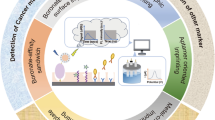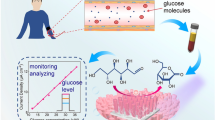Abstract
We report on an electrochemical DNA biosensor consisting of a glassy carbon electrode modified with a film of electropolymerized Eriochrome Black T (pEBT) that serves as a functional platform for the immobilization of probe DNA. pEBT was deposited via cyclic voltammetry, and the amino-modified DNA capture probe was covalently linked to the surface via a sulfanilamide coupling reaction. The single step of the assembly process was monitored by atomic force microscopy and electrochemistry. The surface density of DNA probe on the biosensor interface was calculated to be 1.7 × 10−10 mol cm−2 using methylene blue as an electroactive probe. Hybridization experiments showed the peak currents of methylene blue to decrease with increasing concentration of complementary sequence in the range from 5.0 f. to 5.0 pM. The detection limit is as low as 0.11 fM. Selectivity studies showed that the biosensor can discriminate a fully complementary sequence from a single-base mismatch, three-base mismatch, and a fully non-complementary sequence. The biosensor displays good stability and can be regenerated due to the beneficial effects of electropolymerization and covalent immobilization of probe DNA.

A novel DNA biosensor was fabricated through a facile sulfamide coupling reaction between probe DNA and eriochrome black T that electropolymerized on a glassy carbon electrode





Similar content being viewed by others
References
Kwon SJ, Bard AJ (2012) DNA Analysis by application of Pt nanoparticle electrochemical amplification with single label response. J Am Chem Soc 134:10777–10779
Wang QX, Shi JL, Ni JC, Gao F, Gao F, Weng W, Jiao K (2011) DNA hybridization biosensor using chitosan-carbon nanotubes composite film as an immobilization platform and [Cu(bpy)(MBZ)2(H2O)] (bpy = 2,2′-bipyridine, MBZ = p-methylbenzoate) as a novel redox indicator. Electrochim Acta 56:3829–3834
Sobek J, Aquino C, Weigel W, Schlapbach R (2013) Drop drying on surfaces determines chemical reactivity—the specific case of immobilization of oligonucleotides on microarrays. BMC Biophysics 6:1–13
Dong X, Lu XC, Zhang KY, Zhang YZ (2013) Chronocoulometric DNA biosensor based on a glassy carbon electrode modified with gold nanoparticles, poly(dopamine) and carbon nanotubes. Microchim Acta 180:101–108
Loo AH, Bonanni A, Pumera M (2013) An insight into the hybridization mechanism of hairpin DNA physically immobilized on chemically modified graphenes. Analyst 138:467–471
Hu Y, Wang K, Zhang Q, Li F, Wu T, Niu L (2012) Decorated graphene sheets for label-free DNA impedance biosensing. Biomaterials 33:1097–1106
Zhang X, Gao F, Cai X, Zheng M, Gao F, Jiang S, Wang Q (2013) Application of graphene-pyrenebutyric acid nanocomposite as probe oligonucleotide immobilization platform in a DNA biosensor. Mater Sci Eng C 33:3851–3857
Vermeeren V, Wenmackers S, Daenen M, Haenen K, Williams OA, Ameloot M, Vande Ven M, Wagner P, Michiels L (2008) Topographical and functional characterization of the ssDNA probe layer generated through EDC-mediated covalent attachment to nanocrystalline diamond using fluorescence microscopy. Langmuir 24:9125–9134
Wang F, Hu SS (2009) Electrochemical sensors based on metal and semiconductor nanoparticles. Microchim Acta 165:1–22
Budnikov HC, Evtugyn GA, Porfireva AV (2012) Electrochemical DNA sensors based on electropolymerized materials. Talanta 102:137–155
Zhang YZ, Huang L (2012) Label-free electrochemical DNA biosensor based on a glassy carbon electrode modified with gold nanoparticles, polythionine, and grapheme. Microchim Acta 176:463–470
Shimomura A, Nishino T, Maruyama T (2013) Display of amino groups on substrate surfaces by simple dip-coating of methacrylate-based polymers and its application to DNA immobilization. Langmuir 29:932–938
Li F, Chen W, Dong PJ, Zhang SS (2009) A simple strategy of probe DNA immobilization by diazotization-coupling on self-assembled 4-aminothiophenol for DNA electrochemical biosensor. Biosens Bioelectron 24:2160–2164
Vidal JC, Garcia-Ruiz E, Castillo JR (2003) Recent advances in electropolymerized conducting polymers in amperometric biosensors. Microchim Acta 143:93–111
Korkisch J, Janauer GE (1961) The spectrophotometric determination of thorium with eriochrome black T. Microchim Acta 49:880–883
Zhou H, Wu X, Meng F, Yang J, Wang M (2011) Nucleic acids determination using the complex of eriochrome black T and silver nanoparticles in a resonance light scattering technique. Biomol Spectrosc 78:681–686
Yao H, Sun YY, Lin XH, Tang YH, Huang LY (2007) Electrochemical characterization of poly(eriochrome black T) modified glassy carbon electrode and its application to simultaneous determination of dopamine, ascorbic acid and uric acid. Electrochim Acta 52:6165–6171
Liu X, Luo LQ, Ding YP, Kang ZP, Ye DX (2012) Simultaneous determination of L-cysteine and L-tyrosine using Au-nanoparticles/poly-eriochrome black T film modified glassy carbon electrode. Bioelectrochemistry 86:38–45
Geng MJ, Xua JH, Hu SS (2008) In situ electrogenerated poly(Eriochrome black T) film and its application in nitric oxide sensor. React Funct Polym 68:1253–1259
Chen JH, Zhang J, Wang K, Lin XH, Huang LY, Chen GN (2008) Electrochemical biosensor for detection of BCR/ABL fusion gene using locked nucleic acids on 4-aminobenzenesulfonic acid-modified glassy carbon electrode. Anal Chem 80:8028–8034
Hu YW, Yang T, Wang XX, Jiao K (2010) Highly sensitive indicator-free impedance sensing of DNA hybridization based on poly(m-aminobenzenesulfonic acid)/TiO2 nanosheet membranes with pulse potentiostatic method preparation. Chem Eur J 16:1992–1999
Sabatani E, Rubinstein I (1987) Organized self-assembling monolayers on electrodes. 2. Monolayer-based ultramicroelectrodes for the study of very rapid electrode kinetics. J Phys Chem 91:6663–6669
Gu JY, Lu XJ, Ju HX (2002) DNA sensor for recognition of native yeast DNA sequence with methylene blue as an electrochemical hybridization indicator. Electroanalysis 14:949–954
Zhang W, Yang T, Zhuang XM, Guo ZY, Jiao K (2009) An ionic liquid supported CeO2 nanoshuttles–carbon nanotubes composite as a platform for impedance DNA hybridization sensing. Biosens Bioelectron 24:2417–2422
Yang T, Zhou N, Zhang YC, Zhang W, Jiao K, Li GC (2009) Synergistically improved sensitivity for the detection of specific DNA sequences using polyaniline nanofibers and multi-walled carbon nanotubes composites. Biosens Bioelectron 24:2165–2170
Komarova E, Aldissi M, Bogomolova A (2005) Direct electrochemical sensor for fast reagent-free DNA detection. Biosens Bioelectron 21:182–189
Cha J, Han JI, Choi Y, Yoon DS, Oh KW, Lim G (2003) DNA hybridization electrochemical sensor using conducting polymer. Biosens Bioelectron 18:1241–1247
Ghanbari KH, Bathaie SZ, Mousavi MF (2008) Electrochemically fabricated polypyrrole nanofiber-modified electrode as a new electrochemical DNA biosensor. Biosens Bioelectron 23:1825–1831
Bo Y, Yang HY, Hu Y, Yao TM, Huang SS (2011) A novel electrochemical DNA biosensor based on graphene and polyaniline nanowires. Electrochim Acta 56:2676–2681
Yang J, Yang T, Feng Y, Jiao K (2007) A DNA electrochemical sensor based on nanogold-modified poly-2, 6-pyridinedicarboxylic acid film and detection of PAT gene fragment. Anal Biochem 365:24–30
Acknowledgments
The work is supported by the National Natural Science Foundation of China (No. 21275127), Key Research Foundation of Fujian Education Department (No. JA11166), Natural Science Foundation of Fujian Province (No. 2011J01059), Program for New Century Excellent Talents in Fujian Province University (No. JA12204), and Key Provincial University Project of Fujian (No. JK2011032).
Author information
Authors and Affiliations
Corresponding author
Electronic supplementary material
Below is the link to the electronic supplementary material.
ESM 1
(DOC 244 kb)
Rights and permissions
About this article
Cite this article
Wang, L., Liao, X., Ding, Y. et al. DNA biosensor based on a glassy carbon electrode modified with electropolymerized Eriochrome Black T. Microchim Acta 181, 155–162 (2014). https://doi.org/10.1007/s00604-013-1085-5
Received:
Accepted:
Published:
Issue Date:
DOI: https://doi.org/10.1007/s00604-013-1085-5




